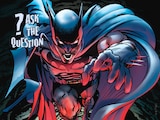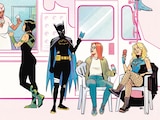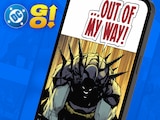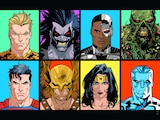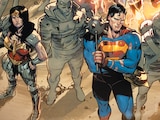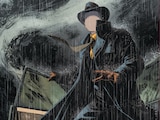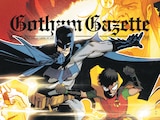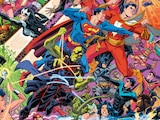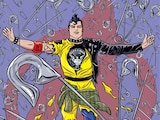What's one word that comes to mind when you think of DC? Action? Adventure? Superheroes? Legacy? All completely valid, but in this writer's opinion, no word is more synonymous with DC than “Crisis.”
To non-informed ears, that might sound dramatic, but in this case it's not a negative or a commentary on the state of the publishing industry. Instead, it's about Crisis as a narrative concept—one that has shaped the history of DC time and time again. With the release of the highly anticipated animated sequel Justice League: Crisis on Infinite Earths - Part Two, it seems like a perfect time to look back at the origins of term and offer up a reading list for those who want to revisit the very earliest days of one of the most impactful words in DC history.
Like so many of the best ideas in DC history, the notion of "Crisis" was introduced by the legendary writer Gardner Fox. Following up on the work that he began two years earlier with artist Carmine Infantino on the concept of two distinct DC Earths in "The Flash of Two Worlds" in The Flash #123, Gardner—under the editorial purview of Julius Schwartz—brought together two of his most notable creations in 1963. The new teamed up with the old in Justice League of America #21-22 when the JLA met their Earth-Two counterparts, the Justice Society of America, in a story called "Crisis on Earth-One," introducing the soon-to-be legendary term to DC canon.

The melding of the Golden Age with the Silver Age proved popular and multiversal team-ups gave Fox the chance to introduce readers of the '60s to his creations from the '40s. Thus was born an intergenerational crossover like nothing else!
The concept was so popular that it soon became an annual tradition in the pages of Justice League of America by Fox and artist Mike Sekowsky. Earth-Three and the Crime Syndicate were introduced in 1964's Crisis two-parter in issues #29-30. 1965's event took place in issues #37-38 and introduced Earth-A, another villainous reality that proved far less compelling than Earth-Three, and so in 1966, Fox went back to basics with a Crisis crossover refocusing on the first two Earths in issues #46-47.
Sekowsky stuck around for one more sci-fi slugfest in 1967's Crisis two-parter in issues #55-56, and Gardner was joined in 1968 by artist Dick Dillin for a Crisis that would fittingly become the writer's final work on Justice League of America in issues #64-65. Dillin continued on with young writer Denny O'Neill for Crisis events in both 1969 (issues #73-74) and 1970 (issues #82-83), and the artist was joined by writer Mike Friedrich for a battle with Solomon Grundy in 1971's Justice League of America #91-92.

That transition from old guard to the new did nothing to dampen the inventive and experimental tradition of the DC Crisis which, at this point, had been around for almost a decade, and it became a playground for some of the future legends of comics. After future Batman game changer O'Neill, there was another vibrant talent on the horizon who began to expand on what had come before, stretching the length of the stories and his own imagination in the process.
Innovative writer Len Wein was the first to shake up the two-parter format established by Fox with a three-part collaboration with mainstay artist Dillin in the landmark Justice League of America #100-102 in 1972, where Wein took the opportunity to revive the long-forgotten Seven Soldiers of Victory, another Golden Age DC team. The duo pushed the envelope yet again in 1973's Justice League of America #107-108, creating Earth-X and the Freedom Fighters. However, they scaled things back with the first and only single-issue Crisis, which featured a Sandman-centric tale in 1974's Justice League of America #113.
Things took a decidedly meta turn in 1975's Justice League of America #123-124 when Dillin was joined by writers Cary Bates and Elliot S! Maggin for a Crisis event starring...Cary Bates and Elliot S! Maggin? Yep, Earth-Prime (basically, our "real" Earth) bled into the two more heroic realities and things got weird as they only could in the far-out '70s. It was a trailblazing concept that we'd see being used time and time again throughout DC history, most famously in Grant Morrison's cult classic Animal Man run.

A year later, E. Nelson Bridwell and Marty Pasko joined Dillin for the Shazam-focused “Crisis on Earth-S” in 1976's Justice League of America #135-137, and Paul Levitz teamed up with Pasko and Dillin for 1977's Crisis featuring the futuristic Legion of Super-Heroes in issues #147-148.
If that wasn't enough talent for you, then as the decade came to an end, writer Gerry Conway tackled his first Crisis with Dillin in 1978's Justice League of America #159-160. The pair did a murder mystery Crisis in 1979's issues #171-172, setting the stage for the controversial Identity Crisis decades later. They then traveled to the Fourth World for 1980's Crisis in Justice League of America #183-185.
Foreshadowing important Crises yet to come, Conway was joined by the masterful George Pérez in 1981 for Justice League of America #195-197. Then in 1982, Conway blew up the standard format with the five-part “Crisis on Earth-Prime,” running not only in Justice League of America #207-209 with Don Heck, but also alternating with Roy Thomas and Adrian Gonzales' All-Star Squadron #14-15. The multiple-issue event is the norm now, but in the early '80s it was a rarity at best.

Conway and Thomas would reunite a year later for a simpler approach in Justice League of America #219-220 alongside artist Chuck Patton, and a young Kurt Busiek partnered with Alan Kupperberg for what would become the last normal two-parter in Justice League of America #231-232 in 1984. That note is vital because what came next would change comics forever.
Up until now, the concept of a Crisis represented an ongoing expansion of the multiverse, an annual occasion to reintroduce beloved characters of the past and generate new ones for the future. However, 1985 would forever redefine the meaning of Crisis at DC Comics. It all began that January with Crisis on Infinite Earths #1 by Marv Wolfman and George Pérez. These storytellers sought to invert the original narrative and use a Crisis as a means to condense DC's sprawling multiverse into a single streamlined universe, reversing Fox's original intention.

As the year-long limited series depicted a complex and emotional tale that would change everything, there was an opportunity for the Justice League to do one more annual Crisis in the original mold. This time it began in the pages of Infinity Inc. #19 by Thomas, his wife Dann, and breakout artist Todd McFarlane. That tale continued into a story titled "The Final Crisis" by Conway and artist Joe Staton in Justice League of America #244. Finally, as the game-changing year came to a close, Crisis on Infinite Earths #12 hit shelves in December. DC's classic continuity was retired and the Post-Crisis era of DC officially began.
This, as most of you well know, is by no means the end of the Crisis legacy at DC. In fact, the word is alive and well, getting repurposed time and time again for big crossover events across the past forty years. But this marked the end of the Justice League's annual tradition of cavorting with their alternate reality counterparts. These old tales were fun adventures that didn't necessarily change the publishing landscape, but entertained and intrigued readers with multiversal shenanigans, expanding the JLA's lore two terrific issues at a time. And, of course, without them we'd likely never have made it to the genre-defining Crisis on Infinite Earths and it’s currently unfolding animated adaptation.
Justice League: Crisis on Infinite Earths – Part Two is now available on 4K UHD, Blu-ray and Digital.
Rosie Knight is an award-winning journalist and author who loves Swamp Thing, the DC Cosmic and writing the monthly gossip column here at DC.com. You can also listen to her waxing lyrical about comics, movies and more each week as she co-hosts Crooked Media's pop-culture podcast, X-Ray Vision.




